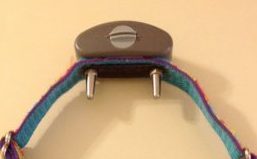
I’m going to be honest that this article has been very hard for me to write. I’ve started and stopped multiple times over the last few weeks now. Shock collars or e-collars are something I’m very passionate about people not using and I would love to see the U.S. to ban the their use like many other countries across the globe including Wales, UK, Australia, Denmark, Norway, Sweden, Austria, Switzerland, Slovenia, and Germany. Banning prongs and choke chains too would be a step in the right direction too.
How shock collars work is you attach a small battery driven device on the dogs neck, tight enough that the metal prongs on the collar make contact with their skin. Then the human uses a remote control device to emit a electrical or static shock to the dog whenever the dog does something incorrect. There are some other variations of collars. Some shock automatically whenever the dog barks oftentimes referred to as a “bark collar.” Others work in tandem with an underground electric fence to keep the dog within an area without having a physical barrier to contain them (like a chain linked fence).
The first issue I have is that you are causing your dog pain. While these collars do come with various settings most owners find they have to use much higher settings than normal to see any results. I have witnessed many dogs wearing these devices actually yelping with pain at each correction and these dogs receiving this level of correction over and over without any real change of behavior. The dogs struggle to understand what to do to make the pain stop.
The next issue is this training only tells the dog what NOT to do. We covered some of why that doesn’t work in our previous Do or Do Not article. The gist of that is if you’re trying to get your dog to stop jumping on your guests when they come into your home by only punishing the “wrong” behavior, you aren’t helping your dog figure out the right one. This results in more punishments and fewer rewards which amounts to slower learning. He’ll also have to figure out an “alternative” behavior without your guidance. He might now instead dart out the door or snap at the visitors. In the end we’ll have failed him because we never helped him learn that sitting or greeting the guests with all four feet on the floor was what we actually wanted.
The issue too is that in the hands of an inexperienced trainer, one accidental or poorly timed shock can result in you pairing the wrong two events together. And I would say a majority of owners (and even a fair number of “professionals”) are novices when it comes to timing. Let’s say you accidentally or purposely shock your dog and a few of these times your toddler also happens to walk into the room. Even if you were trying to get your dog to stop doing something else, like eating your shoe, the dog can easily pair the toddler’s approach with pain, so he’ll try to do whatever he can to keep that toddler away. This coupled with most people’s inability to read dog body language is a disaster waiting to happen.
Plus I’ve seen first hand the results of these dogs who come to me after the owner has resorted to a shock collar. Some owners have these devices marketed to them as a “quick & easy fix”. Others watch a handful of short youtube videos on shock collars and see “how fast” they work. Some owners are told to use them when working with a trainer or other “professional.” One of the fear aggressive dogs I’m working with now, is a direct result of using a painful training method to attempt to redirect fear aggression. The owners agree he is far worse now then he was when they first started working with him on his inappropriate behavior.
This facebook video was from another rescue who saved this Cane Corso dog who was sent to a three week e-collar (shock collar) boot camp after he showed some minor resource guarding of his dinner bowl. This video shows how he was returned to his owner and the rescue’s beginning attempts to change his behavior afterwards. For me this video is hard to watch, knowing how natural an issue resource guarding is, biologically it makes sense to horde food and resources to survive, and how horrible of an experience the dog must have had in just three weeks to have turned into this. As you watch him in the crate, notice how his head snaps side to side and the whites of high eyes are showing, both are extreme signs of stress and fear and clearly are saying: “PLEASE go away, don’t make me have to bite you!”
https://www.facebook.com/DogpalaceDogTraining/videos/889340201203823/?hc_ref=NEWSFEED
The last thing I find exceptionally disturbing is how so many of the “trainers” who promote and use e-collars have a very limited or non-existent background in either dog behavior and/or learning theory. This, in my opinion, causes so many of them to misread the body language their dog gives them while using these devices. The video below doesn’t actually feature either the prong collar or e-collar being used, but instead just shows the collars being put on the dog. While again this video is of someone promoting the use of the e-collar and prong, I 100% DO NOT support either device and firmly stand by that choice and am backed by scientific research showing they are not an effective learning tool.
Before you watch, I’ve broken down a few things to watch for in the video below, but the main thing to notice is how the dog’s movements change before and after the collar has been added:
0:00 – 0:10 – Notice how lose the body language of the dog is. Tail wagging, ears and eyes relaxed.
0:10 – 0:18 – As she approaches with the devices, the dog jumps away from her, although playful, he has to be called back to her to put the collar on.
0:18 – 0:20 – Again, even while is describing her dog as being “happy” he is actively moving away from her.
0:20 – 0:30 – As she attaches the device, the tail wagging slows, you see some beginning stress signals of him licking his lips.
0:30 – 0:32 – He is released and immediately moves away from her again. Does a head shake, feels the collar and immediately sits.
0:32 – 0:38 – She has to call him from his frozen sit position, and while he comes, he then immediately bounds away from her and goes right back to sitting. To me this is the worst, because he is no longer bounds around like a happy goofball, but only sits. “Sit” has has found is a safe position which likely does not trigger the shock.
0:38 – 0:50 – As she zooms in the camera towards him, he avoids eye contact, turning his head away. Lots of stressful lip licks here. Some could be from the camera being so close, but regardless of the reason, she mistakenly again, classifies him as being “happy.” He stays frozen in “sit” though not offering any of the bouncy enthusiasm for live we saw in the beginning. Tail stops wagging too.
0:50 – 1:05 The jingle of the prong collar elicits more licking of the lips. After it is attached, another bound away, lip licks and a shake of the head. And falls right back into a sit.
1:06 – end – As she reaches for the collar, notice how he leans away from her again and his whole body stiffens a bit. Then he remains frozen for the rest of the video, only his tail wags slightly but not like we saw in the beginning.
The thing everyone seems to forget is a wagging tail does not equal happiness. It can be used for all sorts of different meanings, appeasement or calming behavior to deescalate a scary situation, a joyous greeting or even a stiff tail to tell folks the dog means business. I’ve seen animal abusers who are actively hitting their dog who’s tail still wags in an effort to try to deescalate the situation so they can escape. Tail wag != happiness.
Last thing of note, and one that is demonstrated by the videos above is that the e-collars act not as a training tool but as a management tool. For the dogs to continue to “behave” they must always have the collar on and continue to receive shocks for the wrong choices they make. And to me that isn’t practical or fair. I want my dog to actually learn, think, and be creative. I don’t want an obedient servant who bows to my will. I want a lovable canine companion who wants and chooses to be with me. And I hope you want that too!
